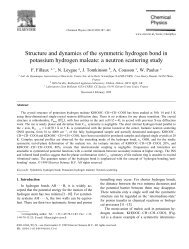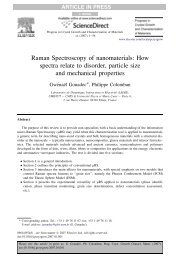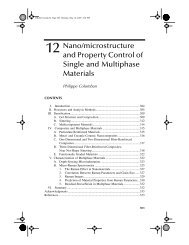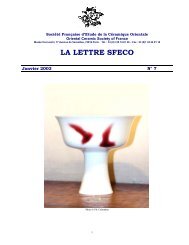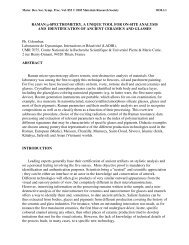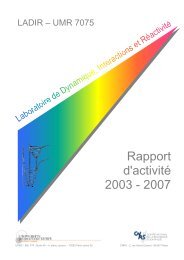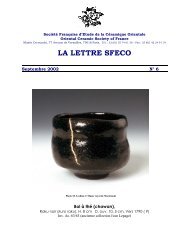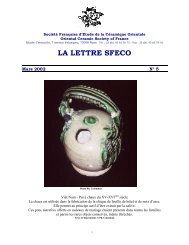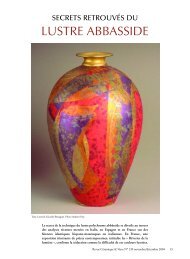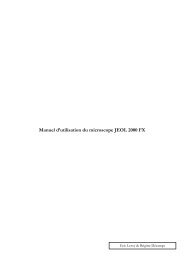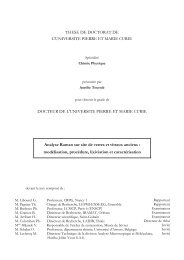Where are Protons and Deuterons in KHpD1âpCO3? A Neutron ...
Where are Protons and Deuterons in KHpD1âpCO3? A Neutron ...
Where are Protons and Deuterons in KHpD1âpCO3? A Neutron ...
You also want an ePaper? Increase the reach of your titles
YUMPU automatically turns print PDFs into web optimized ePapers that Google loves.
1280 F. Fillaux <strong>and</strong> A. Cousson<br />
ever, s<strong>in</strong>ce the quantum theory does not predict any def<strong>in</strong>ite divid<strong>in</strong>g l<strong>in</strong>e between<br />
quantal <strong>and</strong> classical regimes, macroscopic quantum behaviour is possible<br />
for systems decoupled from, or very weakly coupled to, the surround<strong>in</strong>gs [7]. In<br />
pr<strong>in</strong>ciple, there is no upper limit <strong>in</strong> size, complexity, <strong>and</strong> temperature, beyond<br />
which such systems should be doomed to classicality.<br />
As a matter of fact, defect-free crystals <strong>are</strong> macroscopic quantum systems<br />
with discrete phonon states at any temperature below melt<strong>in</strong>g or decomposition.<br />
This is an unavoidable consequence of the translational <strong>in</strong>variance of the lattice.<br />
Yet, the dichotomy of <strong>in</strong>terpretation arises for O-H…O hydrogen bonds, when<br />
the coexistence of two configurations, say O1–H…O2 <strong>and</strong> O1…H–O2, is conceived<br />
of as “disorder” [8]. <strong>Protons</strong> <strong>are</strong> thought of as dimensionless particles,<br />
with def<strong>in</strong>ite positions <strong>and</strong> momenta, mov<strong>in</strong>g <strong>in</strong> a double-well coupled to an<br />
<strong>in</strong>coherent thermal bath. By contrast, vibrational spectra provide unquestionable<br />
evidences of phonon states show<strong>in</strong>g that the translational <strong>in</strong>variance <strong>and</strong> the<br />
quantum nature of lattice dynamics <strong>are</strong> not destroyed by proton transfer. It is<br />
therefore compulsory to elaborate a purely quantum rationale avoid<strong>in</strong>g any classical<br />
<strong>in</strong>gredient [9].<br />
Such a theoretical framework has been elaborated for the crystal of potassium<br />
hydrogen carbonate (KHCO 3 ) made of hydrogen bonded centrosymmetric dimers<br />
(HCO 3 – ) 2 separated by K + entities [10, 11]. The coexistence of two configurations<br />
for protons was first regarded as statistical <strong>in</strong> nature [12, 13]. However,<br />
vibrational spectra (<strong>in</strong>fr<strong>are</strong>d, Raman, <strong>in</strong>elastic neutron scatter<strong>in</strong>g-INS) <strong>and</strong> neutron<br />
diffraction evidence the macroscopic quantum behaviour of protons <strong>and</strong><br />
theoretical arguments suggest that this behaviour is <strong>in</strong>tr<strong>in</strong>sic to the crystal state<br />
[14, 15, 16, 17, 18].<br />
In the present paper, we exam<strong>in</strong>e whether macroscopic states survive <strong>in</strong> a<br />
mixed crystal KH p D 1–p CO 3 , grown from a water solution composed of H 2 O,<br />
HDO, D 2 O molecules. S<strong>in</strong>ce there is no segregation of H <strong>and</strong> D atoms <strong>in</strong>to<br />
separate doma<strong>in</strong>s or clusters, it might seem straightforward to suppose that the<br />
crystal is a mixture of HH, HD, DD dimers, with probabilities p 2 ,2p(1–p), (1–p) 2 ,<br />
respectively [19, 20]. A r<strong>and</strong>om distribution of such dimers should destroy the<br />
translational <strong>in</strong>variance of the crystal, as well as – needless to say – the space<br />
group symmetry, <strong>and</strong> this should be evidenced by neutron diffraction.<br />
We report below neutron diffraction measurements show<strong>in</strong>g that a mixed<br />
crystal (p ≈ 0.75) is isomorphous to the pure analogues KHCO 3 <strong>and</strong> KDCO 3 .<br />
This is at variance with any r<strong>and</strong>om distribution of H <strong>and</strong> D nuclei, so the<br />
concept of macroscopic states previously elaborated for pure crystals should hold<br />
for isotope mixtures, as well.<br />
The organization of this paper is as follows. The crystal structure of KHCO 3<br />
at 300 K is presented <strong>in</strong> Sec. 2 <strong>and</strong> the theoretical framework for H or D macroscopic<br />
states is presented <strong>in</strong> Sec. 3. In Sec. 4 we present evidences of macroscopic<br />
proton states obta<strong>in</strong>ed with neutron diffraction. F<strong>in</strong>ally, some consequences<br />
of the P2 1 .a space group symmetry determ<strong>in</strong>ed with neutron diffraction for<br />
the mixed crystal <strong>are</strong> discussed <strong>in</strong> Sec. 5.



